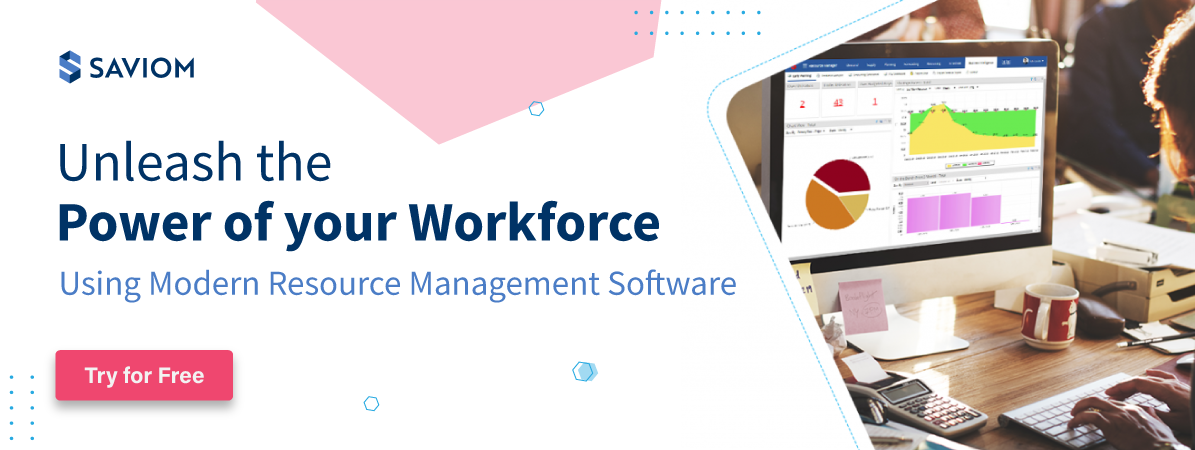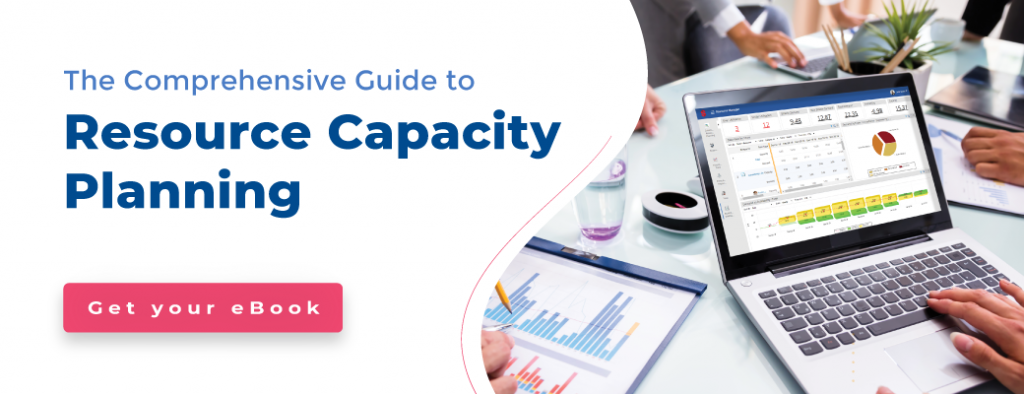What is Resource Management?
Resource management manages business resources efficiently and effectively to get the best value out of them. These resources can be human resources, assets, facilities, equipment, etc.
Efficient management process centralizes the data into a single repository and provides a single version of the truth. The components include resource scheduling, resource forecasting, capacity planning, resource planning, business intelligence/reporting, integration with other related applications, and more.
Resource management as an independent discipline
Resource management is not included in traditional software solutions, which are already there in the market for the last several years. Some of these known tools, such as ERP, PPM, CRM, HR, etc. capture many resources and project-related data during its lifecycle. However, they were never designed to provide a dedicated and integrated solution for utilizing resources.
A dedicated resource management planning solution must integrate seamlessly with these existing applications for data consistency and address all resources related issues. Thus, we define the resource management subsystem as the missing piece of the jigsaw puzzle in this entire ecosystem.
Why is Resource Management important for a business?
Now resource management is no more a luxury for a business. In recent years it has become a very critical part of the success of a business. This can potentially play a significant role in the profitability and sustainability of the business. These are some of the pertinent reasons.
Reason 1: Maximize ROI on your resources
Enterprise resources are the most significant investment in any business. Spreadsheets or entry-level solutions can’t manage them efficiently. One requires a comprehensive and enterprise-level solution for this purpose.
Reason 2: Overcome Complexities of the Matrix Structure
Over the decades, many organizations have evolved into a matrix structure where an employee has multiple reporting lines. This becomes more complex when the resources are distributed in multiple geographies. In such an environment, it becomes incredibly complex and challenging. An enterprise-level resource management solution is required to overcome these complexities.
Reason 3: Forecast and Maximize Billable/Strategic Resource Utilization
High resource utilization alone is not necessarily an indication of the effective management planning of resources. They need to be engaged in billable or strategic projects rather than spending time in mundane activities. An enterprise-level solution can help you forecast and take corrective actions ahead of time.
Reason 4: Futureproof your Workforce Against the Market Volatility
With the outbreak of the Covid-19, organizations are trying to stay afloat in these volatile market conditions with a shrinking budget. Capacity planning, an integral part of resource management solution, can futureproof the workforce against market volatility.
Reason 5: Overcoming Challenges of Globalization with Low-Cost Resources
Globalization has made business highly competitive due to the availability of cheaper resources from low-cost countries. These conditions are compelling in many organizations to evaluate their resourcing strategies critically.
Reason 6: Foster Shared Services Model to maximize resource efficiency
The specialized resources can be utilized in multiple projects instead of tagging them to a single project or a specific department. It ensures that the entire organization gets the benefit, and the capacity of these resources are effectively leveraged.
Evolution and Development of Resource Management
History of Resource Management
To carry out any activities or tasks, you always need resources. The concepts of Resource Management have been there since time immemorial. But it has always remained buried within other areas such as Project Management or Human Resources Management.
It was first recognized as an independent discipline in the 1990s. However, it gained momentum when Matrix Organizations attained its maturity level and became an integral part of any business. Since then, it has gone through multiple transformations:
1st Gen. Spreadsheet Based Resource Allocation Tool
In the early days, the resource allocations were carried out using silos of spreadsheets. It was the first attempt to build an internal resource-centric solution in the 1990s. Although easy to develop, it was very tedious, limiting, and a nightmare to maintain.
2nd Gen. Home-grown Resource Allocation Tool
Due to the limitations of the spreadsheet-based solutions, the businesses developed home-grown tools. These tools were half-baked and very costly to maintain and enhance. It also had minimal capabilities and needed in-house IT staff for maintenance.
3rd Gen. Centralized Visual Resource Scheduling Tool
Client-Server Technology reached its maturity level by 2000. The market started witnessing off-the-shelf resource scheduling software with visual drag-and-drop capabilities. Real-time Resource Scheduling became possible because of a centralized database.
4th Gen. WEB Based Visual Resource Scheduling Tool
The rise of the Internet led to the explosion of “Web-based 3 tier Architecture” for software development. Of late, the market started seeing WEB based resource scheduling tools. These tools were mostly confined to the resource scheduling process and had limited planning capabilities.
5th Gen. WEB Based Enterprise Resource Management Solution
The importance of resource management planning as a separate tool has been well established, giving birth to 5th generation software. It helps utilize local and global resources to reduce costs and increase profitable utilization. It also performs demand capacity planning, provides visibility of resources, and more.
What are the Advantages of Resource Management?
An ad-hoc approach to any solution is prone to human error, time-consuming, and ineffective. It is essential to use an appropriate enterprise-level solution for this purpose. Organizations must balance their resources’ capacity and demand, forecast future requirements, and optimize overall resource utilization.
Following are some of the business benefits of a sound resource management solution:
Optimize Cost: Reduce Resource Related Expenses
Get complete visibility of all resources in real-time and allocate the right resources to the right project with enterprise scheduling. Minimize wasteful hiring/firing costs by forecasting project vacancies, people on the bench, and hot skills.
Human Capital Benchmarking reveals that “The average hiring cost and lead time to hire is $ 4,129 and is 42 days, respectively”
Increase Revenue: Maximize Profitable Resource Utilization
Forecast utilization ahead of time and take corrective actions early after segregating it into billable, non-billable and strategic categories. Move resources from non-billable activities to billable work as appropriate. Tracking forecast versus actual utilization helps avoid billing loss.
Futureproof Your Workforce: Plan Ahead for Upcoming Projects
Identify resource shortfalls/excesses ahead of time using demand capacity planning. Explore different channels to bridge the gap effectively. Forecast and ensure that excess capacity is not wasted. Align sales and delivery by planning and forecasting pipeline opportunities.
Leverage Globalization effect: Utilize Resources Across Matrix Boundaries
Control the project cost by utilizing generic resources from low-cost locations. Utilize High skilled resources to provide training and mentoring. Implement a multi-location policy if local resources are not available for a specific skill. Provide role-based access for viewing resource competencies and taking actions.
Make Dynamic Decisions: Simulate and Adapt to Minimize Disruption
Build different scenarios for the current situation involving multiple projects. Simulate each scenario after juggling other resource-related parameters. It helps arrive at the best possible outcome using the current resource constraints and addresses resource leveling and smoothing. This can include the stalling of an existing project or increasing its timeline. Finally, select the best scenario and apply it to the project timeline.
Increase Client Satisfaction: Deliver Project Timeline within Budget
Client satisfaction is ensured when there are no delivery related surprises with no budget overrun. It can be achieved by minimizing under/over skilled resources and making the right resource available at the right time. At the same time, identify resource shortfall/excesses in advance and ensure that no resource is overworked or under-utilized.
What are the Resource Management Concepts and its Components?
Over the years, mature organizations have established well-defined resource-centric frameworks for better business efficiency. These are the critical components of an efficient Resource Management solution.
Enterprise Resource Scheduling
Establish a single resource plan across the enterprise by replacing a plethora of spreadsheets. Establish a single source of truth and allocate resources to the projects or non-project work as appropriate.
Distribute your best resources across the projects rather than assigning them to a single high-priority project. Replace a high-cost resource with a low-cost resource and re-deploy the high-cost resource in more critical activities. Allocate the best-suited resource to the task rather than the first available person.
Resource Utilization Forecasting
Forecasting future billable and strategic resource utilization help create a structured plan. It allows the movement of resources from non-billable work to billable work. It also helps to proactively market and sell excess capacity. The cumulative profitable utilization of all its employee determines the efficiency of an organization.
Resource Cost Optimization
Minimize the project cost by utilizing commonly available resources from low-cost locations. Implement a multi-location policy if local resources are not available for a specific skill. Utilize high skilled resources to provide training and mentoring. Utilize a contingent workforce for short term assignments.
According to a recent Deloitte Global Cost Survey, “Cost reduction takes precedence over other business initiatives”.
Management of Matrix Structure
Get the visibility of cost-effective local and global resources by skills and competencies across the matrixed structure. Provide role-based access in the matrix for viewing and making informed decisions. Utilize niche, skilled resources to implement a shared services model for maximum productivity.
Resource Capacity Planning
Forecast shortage/excesses of resources by comparing capacity against demand. Bridge resource gaps by allowing sufficient lead-time to avoid last-minute activities. Do not compromise on the quality of new hires because of time constraints. Avoid hiring/firing cycles by creating the right resource mix consisting of consultants and freelancers in addition to regular employees.
Harvard Business Review points out that “80% of employee turnover is the result of bad hiring decisions”.
Tracking Organization Health Index
Carry out succession planning for critical resources and minimize productivity and capacity loss by controlling unplanned attrition. Involve employees during the decision-making process and refrain from overloading them continuously. To improve organization health, provide suitable opportunities as per their qualifications and experiences to keep them motivated.
Gartner insights reveal that “More than 40% of involuntary attrition stems from career development”.
Real-Time Business Intelligence
Use tailored portals, dashboards, analytics, and reports diligently to future proof business requirements. Allow an end-user to see its relevant information by controlling data visibility with a combination of security rights and advanced filters. Drill down further with a slice/dice of data.
Resource Management and Project Management: Two Sides of the Same Coin
Individuals often misconstrue the difference between Resource Management and Project Management.
Resource Management is perceived to be a byproduct of Project Management. It is incorrect to assume that project management will address all resource management related issues.
On the contrary, resource management is a separate discipline, which complements project management and many other applications used within an enterprise.
Resource Management adopts methodologies close to the HR function and the Project Management Office (PMO). As a resource-centric application, it gives a fair understanding of workforces and valuable insights. It could help plan your hiring or training activities and maximize the output of the existing resources.
Project Management’s functionality remains strictly within the PMO. It ensures the quality and timely delivery of different projects. The project manager is also responsible for controlling the budget, and the resource cost is a significant component of the same.
Case Study: How a Successful Enterprise Manage their Resources
We are describing the resource-centric ecosystems within an IT services company for this case study. It is a global company having a presence in different countries and cities.
Background
Because of the size and presence in multiple geographies, the organization has created a matrix structure with multiple reporting lines. It leverages both local and global resources for the delivery. It also allows you to keep control of costs without compromising the quality.
Resources are distributed across the globe, depending on their specific job roles. However, delivery centers in certain pre-decided locations employ a maximum number of resources.
Matrix Organizational Structure
There are two different dimensions to this matrix organization. Sectors represent the vertical, while the competencies are the horizontal part of the matrix. Examples of sectors can be Banking and Finance, Industrial, Government, among others. Competencies include resources with specific technical skill sets such as .NET, Java, Oracle DBA, etc.
Most of the resources belong to the competency, but sectors also maintain certain high-skilled resources with specialized domain knowledge. Sector representatives are responsible for carrying out business development activities, while the competency takes care of the project delivery.
Operating Model
A new lead always comes via the salesperson closer to the client and working out of the same location. The sector representative of the delivery organization gets involved in business development/pre-sales work. They provide the necessary support to the concerned sales personnel to secure the deal.
Once the opportunity reaches a certain probability of closure, the resource-related activities kicks-in. Based on the skillset and the number of resources required, competencies and corresponding resource managers start resource and capacity planning.
Based on the size and the scale, project-specific hiring takes place. Otherwise, resource managers take stock of existing resources, getting rolled off, bench, and contingency resources. It helps them to decide if they will be able to fulfill this new requirement. If it is not possible to meet the demand using the available channels, the hiring team gets involved in resource planning.
Resource Lifecycle Management
Once a new project gets initiated, it goes through various stages of resource requirements. It can have an initial ramp-up and later a ramp-down phase. This gets adjusted according to the demand. The concerned resource managers ensure that the right resources are available at every stage.
The entire activity is planned such that once a resource is released from a project, a new opportunity is already identified. It cuts down the bench time and increases resource utilization.
In summary, a resource always belongs to the competency. It has dual reporting once the concerned person is assigned to a project for a specific duration. Once the engagement finishes, the same resource gets assigned to a different project with a new project manager. But he/she continues to report to a single line manager who does performance review and carries out other managerial responsibilities.
The competencies also maintain a pool of Subject Matter Experts (SMEs). These SMEs take up additional responsibilities of mentoring junior resources and helping out during delivery related challenges.
What to look for in a Resource Management Solution?
The need for each organization is unique, and the selection of software must be carefully made. Cost always plays a vital role in any selection process.
Many times, organizations compromise on the tool quality based on its price and overlook its long-term benefits. As a result, they solve their resource-related problems with some home-grown or entry-level software or silos of spreadsheets.
We recommend organizations consider a “Total Cost of Ownership” based on selecting any specific software. Following are some of these criteria that can help to evaluate a perfect resource management planning software: ––
User Interface (UI) and User Experience (UX) and Navigation
The end-user of the product must be comfortable with the user interface, different colour combinations, ease of navigation, etc. One can find the required information effortlessly without going through too many clicks.
Manage Geographically Dispersed Matrix Organization Structure
Matrixed organization structure provides multiple reporting lines, which makes resource identification, allocation, and utilization overly complex. The software should be capable of managing resources under those environments and satisfy different stakeholders’ requirements.
Configurability & Expandability
Highly configurable software helps in rapid deployment and provides additional flexibility to the users. It should be expandable and scalable to satisfy the business’s growing needs and provide a competitive edge against rivals.
Capability to Reduce Resource Cost
The software should help a business to do multi-dimensional forecasting around different resourcing parameters. One can get real-time business intelligence to improve performance, profitability, and productivity further.
Real-Time BI: Multi-Dimensional Reports, Analytics, Dashboards
Resource requirements for a complex organization are dynamic and changing every minute in real life. Real-time business intelligence is extremely critical in such a rapidly changing scenario. It provides role-based reports, analytics, and dashboards for fast and accurate decision making.
Integration with Other Legacy Systems
Most businesses have already invested in other enterprise-level systems that have captured resource profiles, competencies, project details, etc. With seamless integration, the suggested software will pull and consolidate this information. It avoids the unnecessary double entry of data and its reconciliation.
High Return on Investment
Any right buying decision must provide a high return within a short amount of time. Implementation and customization work should be completed quickly without a lot of investment. It will be easy to address the change management challenges provided the software is configurable to use organizations’ terminologies.
The Glossary
The SAVIOM Solution
SAVIOM has over 20 years of experience helping multinational clients manage their resources efficiently and effectively. It also provides tools for project portfolio management, professional service automation, and workforce planning software. So, SAVIOM can help your business to establish an efficient system geared towards your specific business challenges.















